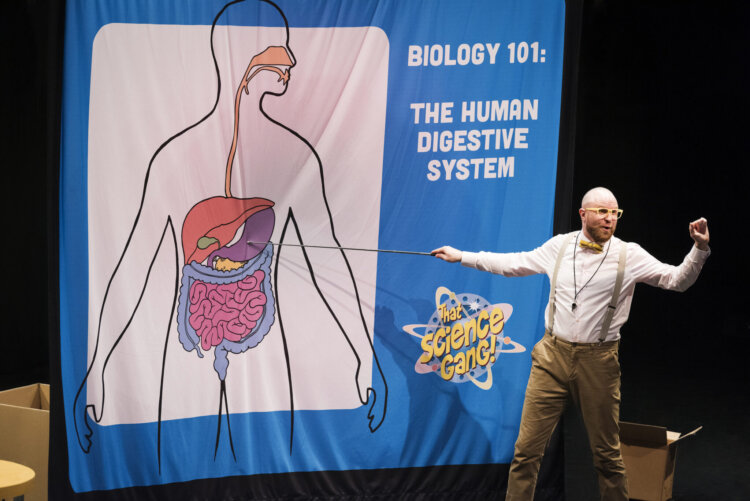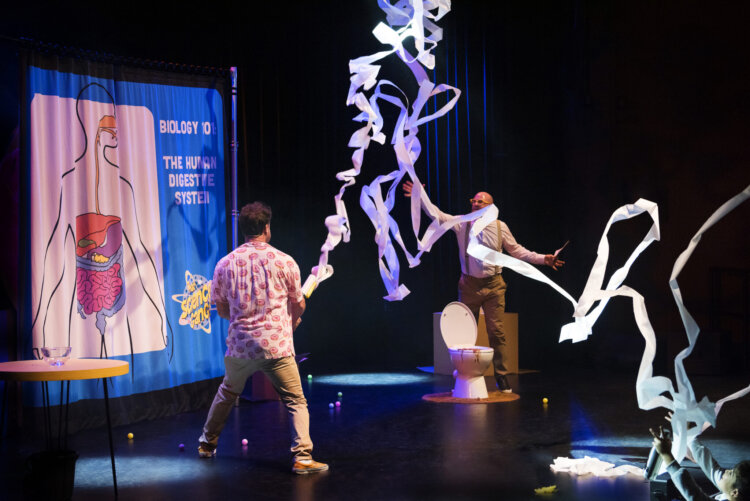If you haven’t heard of “Science Theatre” before now you’re to be forgiven. As a recently evolved genre of live performance, Science Theatre has emerged in response to the growing demand for STEM (Science, Technology, Engineering, and Mathematics) curricula across the Developed World’s education systems.
An increase in AI and technology-based careers across the global economy, initially saw the emergence of STEM-focused curricula.
STEM was introduced to schools to train the workforce of tomorrow and ensure that across the disciplines of science, technology, engineering, math, statistics, biology and more – there would be a suitably ‘hard-skilled’ workforce to fulfil these roles. The left brainers.
According to Pew Research Centre in the US, STEM occupations have grown by 79 percent since 1990 in the US, which is often seen as the looking glass for the rest of the world.
Here in Australia, the National Skills Commission predicted in a report that STEM jobs would grow by 14.2% from 2021 to 2026, twice as fast as non-STEM jobs predicted to grow at 7.4%. Occupations within the Professional Scientific and Technical services field are predicted to increase by 254,600 between May 2024 and May 2034, with 144,500 of those people being required in the first five year period from May 24 – May 2029. 2
The writing (or coding) is on the wall, STEM and technology-based career paths will be the way of the future but what started as a focus on ‘hard skills’ quickly collapsed as even the hierarchy of the business world realised that ‘soft skills’ had an incredibly important role to play.
Image credit: Daniel Burke Photography
The careers that exist within the realm of STEM simply couldn’t be successfully carried out without the softer skills of creativity, communication and collaboration that the arts proliferates.
A report conducted by LinkedIn in 2018 showed that 57 percent of the senior leaders in these STEM fields favoured soft skills over hard skills. Meaning that the curriculum quickly needed to pivot in order for tomorrow’s workforce to be suitably skilled and educated.
Enter the pivot to STEAM, as the A – ART, was added to STEM creating the now prolifically taught curricula of STEAM.
Whilst STEM curricula focused explicitly on scientific, technological, engineering and mathematical skills, the incorporation of ART in STEAM allows for the teaching of tools such as visualisation and imagery; with the performing arts having a role to play in the distillation of often complex concepts into palatable information and the social-emotional skill set required to effectively manage a team of people. As all good leaders do.
The performing arts in all their colourful and creative glory also present an opportunity for knowledge retention, as children’s imaginations are catalysed and captivated. It is no secret that a captivated child learns far more than a disinterested or dispassionate one.
Science Theatre is one of the delightful by-products of our new focus on STEAM as it uses theatre and live performance to educate children almost accidentally; as a welcome and somewhat intended result of exposing children to the performing arts.
YOU ARE A DOUGHNUT! coming to BREC in April for both a Schools show as part of the Creative Learning Program and a General Public performance in the BREC Presents program, is the perfect example of Science Theatre done right.
Trying to teach the complexities of the Digestive System to young children from a textbook is likely to result in disinterest and disengagement. Teaching it through what is effectively an informative and hilarious variety show with rainbow coloured poop puppets and catchy tunes? Well, that makes more sense.
The company behind YOU ARE A DOUGHNUT! That Science Gang created the award-winning The Alphabet of Awesome Science and specialise in using performing arts to engage kids. They also provide pre and post-show activities to further learning.
Science Theatre allows a deepening of understanding in children and allows room for the all-important teaching of desirable personal attributes along the way such as communication, creativity, collaboration and stronger social-emotional intelligence. Not to mention strong benefits to children’s mental health.
The New Victory SPARK (Schools with the Performing Arts Reach Kids) Program was created to expand access to the arts and ensure more students are exposed to the benefits of the Performing Arts. 3
Over three years New Victory was able to study the direct impact of live performance and robust arts programming for SPARK participants.
The SPARK participants not only developed an interest in the performing arts and deepened their empathy and creative thinking, they also built a sense of optimism about what their future holds.
After only one-year of the study, student’s future orientation scores increased by 10%, meaning they felt more optimistic about their own future. By contrast, the control group of the study showed a 5% decrease in their future orientation scores over the same period.
SPARK participants were also asked to engage with improvisation exercises where students were challenged to develop and sustain their own creative scenarios without scripts.
The Report states, “Over time, scenarios got more complex and more detailed as kids got more comfortable with thinking and expressing themselves creatively. The ability to think creatively and problem solve in new ways is a key part of the skill set students will need to succeed across fields of work…”. This very much includes those in the STEM fields.
Ali. P. Gordon, PhD, an associate professor in mechanical and aerospace engineering at the University of Central Florida was quoted as saying, “Programmers and engineers are increasingly teamed up with artists to co-develop software, products, renderings and more,” which illuminates STEM industries already looking to artists within their talent pool in order to balance the need for hard and soft skills. Not unlike the need for Engineers and Riggers as part of Creative Teams to construct and ensure the safety of sets and stunts.1
As a performing arts venue passionate about allowing children the opportunity to be exposed to the arts and be educated in viable career paths for the future, we are certainly very hopeful that the emergence of Science Theatre is just the beginning and that more Educators will recognise the importance of the A in STEAM and ensure the performing arts remains part of the well-rounded education Australian children receive.
Further Reading
2 – https://www.jobsandskills.gov.au/data/employment-projections#downloads
3 – https://www.newvictory.org/about/research/impact-of-performing-arts-on-kids/


